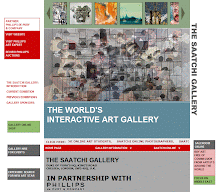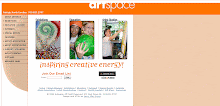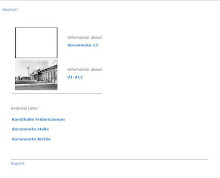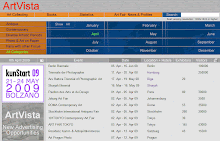Artist: RothkoAbout twenty years ago, a great historian of art, Michael Baxandall, wrote a fundamental book for the methodology of the studies, Patterns of Intention, in which, on the basis of a series of principles, he proposes an “inferential criticism” based on nature and fundamental affirmations that we support when we analyze a work of art. That is to say, “If we think or speak of a picture as, among other things, the product of situated volition or intention, what is it that we are doing?” He analyzes, for instance, the expectations that we have towards the work of art as bearer of the formal values of the period (How can we know them? What value they assume for us? How can we be sure that the public is aware of them?) He studies the relationships between the artist and his potential target, the artist and his colleagues, the artist and his client (Did they use common communicational codes? So then, how can we explain the changing of the taste during history? When we speak about “stylistic influence” what do we mean exactly?) Or, again, the relationship between the work of art and the scientific (or philosophical and economical) theories of its period (How can we affirm that the artistic product mirrors them, and if this reflection is intentional or not?)
All this, taking on Baxandall’s previous studies, is made more complicated from the fact that in order to express any critical judgment, we use a language that is not the one of the work of art, that is to say it’s not the visual or sensorial one. Rather, it is the cultural one, which belongs to the written language and bases itself on its own structures that change throughout time.
In the previously quoted text, the critical effort is displayed in four examples, which are different
for technical typology and periods: an iron bridge, the scotch Fort Bridge; Picasso’s Portrait of Daniel-Henry Kahnweiler; Chardin’s A Lady Taking Tea; and Piero della Francesca’s Baptism of Christ.
The chronological order is not respected, because the matter of method, though applied to different objects, must respect a formal rigour that transcends the specificity of the singular case (however bearing it in our mind).
Apart from that, and from some other few anomalous cases of methodological consciousness, especially in the phenomenological sphere, what would happen if the mental forms of contemporary art history were applied to the concrete production of exhibition catalogues, monographic studies or other scientific occasions, to medieval art? Or vice versa? If we read the Renaissance, as the manuals or the students of art history usually do, as “avant-garde” in the modern twentieth-century sense of the term, we will not understand neither its importance, nor its ways of diffusion, nor even the influences on (and from) the client’s taste.
The mimetic distance from the visual reality that an impressionist, or a futurist, or even a landscapist puts in his works, cannot be measured, neither on the basis of motivation nor on material ways, similar to the iconic allusiveness of Byzantine art. There is a feeling of the loss of references in metaphysical art, for instance, like how we feel when we look at Duchamp’s pissoir or bottle dryer, but also at a steady filming of a skyscraper.
Could this be possible in the art of the fourteenth century? The famous pipe, perfectly mimetic, doesn’t aim to be what it is, as the man of an Irish miniaturist of the early Middle Ages pretends to be what he is not, that is to say a material and recognizable reality.
The examples could be numerous.
Most contemporary critics base themselves on the outpouring of known facts regarding the author of the work of art seen in the work itself. From Picasso to Warhol to Haring we have a large documentation, which has built a sort of a daily agenda. But if we go back to the past ages where the information is fewer this agenda we are less likely to find. Hasn’t Cimabue only been a phase of Italian Art for the Anglo-Saxon world, losing a specific argumentum ad personam? (Not by chance, of his 50-year long activity as an artist we know only two concrete facts, as archival data). So, when we have a scheme of interpretation so lacking in details do we need to eliminate in the critical process the need to turn to biographic analysis? Yet, we are still attached to
the idea of genius and formal independence, especially in periods when the artist is quite far from contemporary representation. Some interpretations of medieval production as craftsmen clashed with the fondness for a history of art made of people, as we have been taught by Vasari: Yes, Antelami and Giotto are in fact multiple productive entities, but they are also – and they must be – identifiable as characters of an absolute level.
The idea of materiality opposed to the one of immateriality is not a key of interpretation exclusively based on the present age. Of course, the “immaterial values” that Bacon expresses with material choices in his manner of painting, in relation to the support constituted by the canvas, don’t follow the same of Titian.
Today, when with a plastic card pretending to be money (immaterial money) we buy two letters pretending to be a pair of jeans, or underwear, this doesn’t have a direct parallel to the Middle Ages, even if the signatures of Calvin Klein and Giotto have something in common. They express an immaterial value of quality with reference to the physicality of the object.
We don’t know what Piero della Francesca was thinking concerning the concrete values of his media, in his projects, perceptively rationalizing spaces and shapes. Sometimes we have the impression that he would gladly give up his tables, lime, and chalk if he had available realities that today we would define as more “virtual” (He could be thought as the remote patron of the supporters of Photoshop and AutoCAD).
While we all know very well Bill Viola’s theoretical speculations about technical devices able to overpass the instant temporality, in order to enter a tradition, that is, in the majority of the cases, deliberately and deeply “classic”.
Early on, Petrarch made a distinction between the learned elite and the uneducated public, between the expectations of the ones “who know” and the simpler ones “who don’t,” the stifling nature of ignorant evaluations like “Ah…look! What a nice painting! It seems like a picture!” and, “Look at this nice picture, it really seems like a painting!” always exist, and constitute the basis of a fundamental matter of art history.
From ancient Greek painters on, from Apelle‘s flowers and fruits, which seem so real that the birds crash into the wall in order to pick them up, some of the principles of evaluation have always been how far is the work of art from the reality that it portrays or suggests, if this distance is consciously achieved, or, vice versa, unintentional and not perceived and, finally, if it is permissible to see in the painting, or sculpture, something different from what materially we see.
In this way, without having any claim to offer a homogenous and coherent key of interpretation, or to be particularly original, it could be useful to have a look at some facts of the history of non-contemporary art regarding some ways to look beyond the materiality of the work of art. To show determinate objects, so it doesn’t count as an historical introduction, a sort of “history of art according to us,” but rather as a playful critical hint to highlight the critical course.
If we speak exactly about feeling of a loss of references, why we don ‘t remind ourselves of the scene in which Giotto, at the end of the thirteenth century, places the viewer from the “wrong side” with reference to the common senses? If we speak of “avant-garde”,
why don’t we call back the examples of conscious self-affirmations of the artist, as in Lanfranco’s, Wigelmo’s or Antelami’s eulogies in Northern Italy between the end of the eleventh and the beginning of the thirteenth century?
When we speak about “iconicity” in today’s art production, and nowadays we abuse this concept without having completely understood it, maybe it is better to keep in our mind a concrete example of Byzantine painting, and of the ways of its mental and visual fruition.
One of the biggest masterpieces of the Italian Renaissance is Piero della Francesca’s Legend of the True Cross, in the church of San Francesco in Arezzo.
As we know, the protagonist of the paintings is the sacred wood: born from Adam’s mouth, recognized by the queen of Sheba, hidden by Solomon, collected and employed to crucify the Savior, brought to light from Elena, mother of Constantine, and became the symbol of the new faith and the Christianization of the Roman Empire.
This is an event that is repeated and evocated through many other periods, whose main point is a common material that becomes extraordinary because it constitutes the physical object on which the death of God as human, the theological absolute reality of the foundation of Christianity, is carried out.
 This is the only aim of the history.
This is the only aim of the history.
But there is no crucifixion scene, it is a stage that is skipped, only physically recalled from the painted wooden cross placed on the altar, mentally perceived as the immaterial entity that this pictorial cycle has determined.
Web:
http://www.rothko.com/
http://www.nybiennaleart.org/the_immaterialism_home.htm
Biography: http://www.rothko.com/biography.shtml
Curator: Fabrizio Lollini
Born in Bologna February 3, 1964.
After receiving a Bachelor degree in Classics (University of Bologna), a specialization degree in Medieval and Modern Art History (State University of Milan) and a Doctorate in History and Critique of Art, he taught Medieval Art History and History of Illumination as an adjunct professor at the University of Bologna in Ravenna and at the University “Ca’ Foscari” in Venice.
He has been a researcher of Medieval Art History at the Department of Visual Arts at the University of Bologna, since November 1, 2002 and has received tenure.
* Institutional activities: in the academic years 2002-03, 2003-04, 2004-05, 2005-06, 2006-07, 2007-08 and 2008-09 he taught the course Medieval Art History for all the undergraduate majors of the Department of Humanities and Philosophy; in the academic years 2004-05 and 2005-06 he taught the course Medieval Art History for the specialization degree in Art History at the University of Bologna; in the academic years 2003-04, 2004-05, 2005-06, 2006-07, and 2007-08 he taught the course Art History of the Middle Ages at the School of Specialization for Higher Education, Art and Drawing major of the University of Bologna; he taught the course and workshops of History of Illumination for the School of Specialization in Medieval and Modern Art History at the University of Bologna for the academic years 2003-04, 2004-05, 2005-06, and 2006-07.
* Master: he held meetings on the subject of medieval art history for the Master in Ecclesiastic Cultural Heritage (University of Bologna, Departments of the Conservation of Cultural Heritage and Law) in the academic years 2002-03, 2003-04, 2004-05, 2005-06, and 2006-07; in the academic years 2004-05, 2005-06, 2006-07, 2007-08 and 2008-09 he held lessons on the subject “Nourishment and visual arts” for the International Master in History and the Culture of Nourishment (University of Bologna, Department of Humanities and Philosophy); he was also sent to hold the same course at the partner site of the Université de Tours in France (2006, 2007, 2008 and 2009).
* He collaborated with the organization of exhibitions at the Malatestiana Library of Cesena (“Corali miniati del Quattrocento nella Bibliotea Malatestiana” and “Libraria Domini” 1989; “La biblioteca di un medico del Quattrocento: i codici di Giovanni di Marco alla Biblioteca Malatestiana” 1998; “Due papi per Cesena” 1999; “Scritte dal dito di Dio. Codici biblici e liturgici manoscritti e a stampa nella Biblioteca Malatestiana” 2002), Imola (“Miniature della Biblioteca Comunale”, Biblioteca Comunale, 2006), Ferrara (“Cosmè Tura e Francesco del Cossa”, Palazzo dei Diamanti, 2007), and in Bologna (“Tra le due sponde dell'Adriatico: la pittura nella Serbia del XIII secolo e l'Italia”, Museo Civico Medievale, 1999; “Il libro si mostra. Dal manoscritto alla stampa attraverso i tesori del Convento dell'Osservanza di Bologna”, Convento dell’Osservanza, 2000; “Uomini denaro istituzioni. L'invenzione dei Monti di Pietà”, Oratorio dei Filippini, 2000; “Duecento. Forme e colori del Medioevo a Bologna”, Museo Civico Archeologico, 2000, of which he also curated the didactic and the CD-rom presentation); he participated in the writing of the catalogue of many other exhibitions (to mention one, “Giotto e le arti a Bologna”, Bologna, Museo Civico Medievale, 2005)
* Sole scientific curator of the exhibition “Corali miniati di Faenza, Bagnacavallo e Cotignola. Tesori dalla diocesi” (Bagnacavallo, Biblioteca Comunale, 2000)
* He curated for the I.B.C. (Institute for Cultural Heritage) of Emilia-Romagna the cataloguing of all the illuminated manuscripts of the Biblioteca Comunale Panizzi in Reggio Emilia (1996-97), and of the Biblioteca Comunale dell’Archiginnasio in Bologna (2003-04)
* Professor at Dickinson College’s (Carlisle, Pennsylvania, U.S.A.) overseas program site in Bologna, Italy where he taught The Arts of Italy in the academic years 2005-06, 2006-07, and 2007-08; in 2007 he was sent to the main campus in Carlisle, Pennsylvania, U.S.A. for conferences and lessons.
* Member of the scientific board of several exhibitions (the most recent “Cosmè Tura e Francesco del Cossa. Arte a Ferrara nell'età di Borso d’Este”, Ferrara, Palazzo dei Diamanti, 2007; “Gotico a Imola 1350-1450”, Imola, Musei di San Domenico, 2008)
* Professor for Education courses in Conservation/Preservation of Cultural Heritage (Region Emilia-Romagna, 1998; City of Bologna, 2000; Comunità Montana of Northern Lazio, 2001)
* International partner for projects of the Academia Romena (Romanian State Academy, Bucharest)
* He was invited to many national and international conferences in addition to those organized by the University of Bologna
* He has written more than one hundred publications (including the catalogues of the complete collection of illuminations of Reggio Emilia and Imola's libraries, and many recent sections of catalogues of exhibition)











































